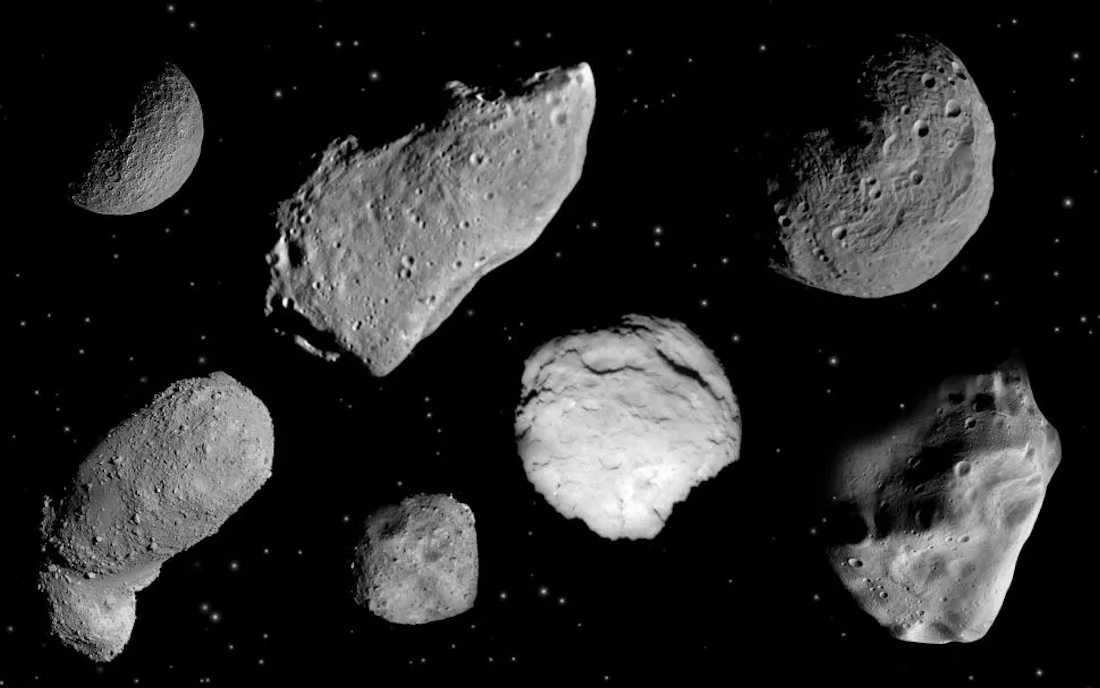Occasionally, reports emerge online stating that scientists have detected an asteroid comparable in size to a soccer field, hurtling towards our planet. Typically, these celestial bodies do not pose a danger to life on Earth, as their presence is often identified well in advance of their proximity to us. However, what if we do encounter an asteroid that genuinely threatens our planet? We will explain how experts evaluate these risks and introduce the concept of a “planetary defense system.”
The distance to cross – 7.5 million kilometers
The information provided in this article is based on the data published in a dedicated section of the official website of the European Space Agency (ESA). According to their findings, there are approximately 30,039 near-Earth asteroids in our solar system as of the end of last year. These rocky bodies orbit the Sun on a trajectory that closely aligns with the Earth’s orbit.
An asteroid, also known as a minor planet prior to 2006, is a relatively small celestial object that orbits the Sun. Compared to planets, asteroids are much smaller in size and mass, and they typically have an irregular shape and lack an atmosphere, although some may have moons.

Near-Earth asteroids (NEA) refer to asteroids whose perihelion distances are equal to or less than 1.3 astronomical units. To simplify, potentially hazardous objects are only considered those that may approach the Earth within a distance of 7.5 million kilometers (or 0.05 astronomical units) in the foreseeable future.
Near-Earth asteroids account for approximately one-third of all asteroids discovered in the solar system. The majority of them are located in the asteroid belt between Jupiter and Mars, as noted by ESA.
Nevertheless, this isn’t the only region of concentrated asteroids. Between the orbits of Jupiter and Neptune, there are constantly about 40 thousand asteroids with unstable orbits and a size larger than one kilometer. These are also referred to as Centaurs. Similar objects can also be found in the Kuiper belt.
"New asteroids are found on a weekly basis."
What is the process of searching for asteroids? Ground-based survey telescopes, like the ones used by the Catalina Sky Survey at the University of Arizona, continuously uncover new asteroids nearly every week. These systems are specifically designed to survey large areas of the sky and identify previously undiscovered objects that are in motion against the backdrop of seemingly stationary stars.

Typically, more specialized telescopes like the Very Large Telescope (VLT) are utilized for further observations. These telescopes allow for better tracking of asteroid trajectories and enable the study of their size and potential composition.
The Gaia telescope, operated by the European Space Agency (ESA), is also contributing to our understanding of asteroid hazards. “Gaia is providing valuable insights into the stars within our galaxy, which serve as a reference for asteroid observations,” explain the observatory’s experts. “By precisely determining the positions of stars, we are able to accurately calculate the orbits of asteroids.”

“Every asteroid that is discovered in close proximity to Earth is categorized as a near-Earth object, however, many of these asteroids are actually found far away from our planet,” states Marco Micheli, an astronomer at ESA’s Coordinating Center for Near-Earth Objects. – These newly discovered asteroids undergo extensive observation over extended periods of time, allowing astronomers to study their movements and predict their future positions based on limited data collected on different nights. Depending on the quantity and accuracy of these observations, scientists can calculate the future trajectory of these asteroids several decades or even centuries in advance.”

Are any of these asteroids on a collision course with Earth?
Asteroids that are one kilometer in diameter or larger are considered to be large and potentially destructive for our planet. However, the asteroids mentioned earlier have been well-studied by scientists, and according to their analysis, none of them pose a risk of colliding with Earth in the near future.
One of the most well-known asteroids of this kind is Chiksulub (or Chikshulub) – a ten-kilometer diameter asteroid that collided with Earth 66.5 million years ago. This catastrophic event caused a series of powerful earthquakes and led to the extinction of the dinosaurs. The impact crater, which is approximately 180 kilometers in diameter and initially reached a depth of 17-20 kilometers, can be found on the Yucatan Peninsula.
The current focus is on asteroids categorized as “medium” with a diameter of several hundred meters. Many of these asteroids are still undiscovered because their relatively small size makes them difficult to detect. “The encouraging news is that over half of the near-Earth asteroids that we know of today have been identified in the past six years. This highlights the rapid advancements in our ability to detect and track asteroids,” explains Richard Moysl, the head of planetary defense at ESA.
To summarize, there are currently about 1,500 asteroids under constant observation with a “non-zero” probability of collision, listed in the “asteroid risks” catalog. However, it is important to note that the term “non-zero” is used loosely, as the actual risk of a collision in the coming decades is trending towards zero.

As an illustration: the highest danger of crashing into a planet out of all the monitored asteroids currently belongs to (101955) Bennu. However, even for this asteroid, the calculation using a specialized logarithmic model yields a value of -1.59. In simpler terms, the probability is 38 times lower than the normal level of risk.
Is it possible to artificially alter the trajectory of an asteroid?
In September of last year, NASA successfully carried out an unprecedented experiment aimed at changing the course of an asteroid through a “directional collision” technique. The space probe DART, traveling at a speed of 22.5 thousand km/h, intentionally collided with the asteroid Dimorph, which is part of the Dimorph-Didymus binary system. This historic event took place approximately 10 million kilometers away from Earth.
In a recent publication, the comprehensive findings of the experiment revealed that the “kinetic impact technology has the potential to safeguard the Earth if the need arises”. The experiment successfully altered the trajectory of Dimorph, reducing its orbit by 33 minutes. Interestingly, this achievement was primarily attributed to the recoil effect generated by the asteroid, which resulted in the formation of a debris “tail” extending over a kilometer and a half. The remnants of this tail remained observable for nearly a month.

An artist’s depiction of the asteroid belt showcases a cluster of celestial rocks. However, in actuality, these rocks are typically spread out by distances of hundreds of thousands of kilometers.
Celestial bodies known as asteroids can be found throughout the Solar System. These objects, which have a diameter greater than 30 meters, orbit the Sun and lack a uniform shape or atmosphere. Additionally, some asteroids may even possess their own satellites.
Origin of the term
The term “asteriskos”, which later transformed into “asteroid”, was coined by the combined efforts of Charles Burney, an English composer, and William Herschel, a German astronomer. Derived from the ancient Greek language, “asteroid” means “resembling a star”. The reason behind this is that unlike planets, which appear as disks, asteroids appeared as star-like points when observed through a telescope, hence the name.

Until 2006, certain small celestial bodies like Ceres were also classified as asteroids.
Origin
Asteroids are celestial objects that originated from the gravitational attraction between dense gas and dust particles orbiting our Sun during its early formation. Some of these entities, such as the asteroid Lutetia, grew in size and developed a molten core. As Jupiter reached its current mass, most of the protoplanets in the original asteroid belt located between Mars and Jupiter were shattered and expelled. During this period, certain asteroids formed through the collision of larger bodies within the gravitational field of Jupiter.
Orbit-based Classification
Asteroids are categorized according to their orbital characteristics and the way they reflect sunlight in the visible spectrum.

The Ephrosyne family of asteroids is observed in the infrared spectrum.
Asteroids are classified into groups based on their orbital characteristics, and among these groups, families can be identified. An asteroid family is defined as a group of asteroids that have similar orbital characteristics, such as semi-major axis, eccentricity, and orbital inclination. These families are not just composed of asteroids that move in close orbits, but are likely fragments of a larger body that broke apart.
The largest known asteroid families can consist of several hundred asteroids, while the smaller ones may only have around ten members. It is estimated that approximately 34% of the asteroids in the main asteroid belt belong to asteroid families.
The formation of the majority of asteroid groups in the solar system led to the destruction of their parent body, although there are a few groups where the parent body managed to survive (for example, Vesta).

Dimensions of the asteroid Vesta and the dwarf planet Ceres
Spectral classification
Spectral classification is determined by analyzing the electromagnetic radiation spectrum produced by an asteroid’s reflection of sunlight. By registering and processing this spectrum, scientists are able to study the composition of the celestial body and categorize the asteroid into one of the following classes:
- The S-group, also known as the silicon asteroid group, is primarily composed of iron, magnesium, and various stony minerals. Due to their composition, these asteroids are often referred to as rocky asteroids. These bodies have a relatively high albedo, allowing some of them, such as Irida, to be observed with just binoculars. Silicon asteroids make up approximately 17% of the total number of asteroids in the Solar System, and they are most commonly found within 3 astronomical units from the Sun. The largest members of the S-group include Juno, Amphitrite, and Herculina.

Eros, an exemplar of the S-class asteroids
- Cluster of iron asteroids or X-group. The least examined cluster of asteroids, which are less common in the solar system compared to the other two spectral classes. The composition of these celestial bodies is still not thoroughly comprehended, but it is known that the majority of them contain a significant proportion of metals, occasionally nickel and iron. It is believed that these asteroids are fragments of the cores of some protoplanets that emerged early in the development of the solar system. They can have both high and low albedos.
Large asteroids
The largest asteroid in the asteroid belt is Ceres. Since 2006, it has been classified as a dwarf planet. Ceres has a spherical shape and is composed of a crust made of water ice and minerals, with a rock core.
Pallada is another notable asteroid. It has a diameter of 532 kilometers and is rich in silicon.
Vesta, with a diameter of 530 kilometers, is the heaviest asteroid. It has a core made of heavy metals and a rocky crust.
Hygeia is a common type of asteroid with a carbonaceous content. It has a diameter of 407 kilometers.
Interamnia is a rare F-class spectral asteroid. It has a diameter of 326 kilometers.
Europa has an elongated orbit and a diameter of 302.5 kilometers. Its surface is porous.
The size of Asteroid David is between 270 and 326 kilometers in diameter.
Asteroid Sylvia is known for having at least two satellites and its diameter measures 232 kilometers.
Asteroid Hector has a unique shape similar to a peanut, with measurements of 370 × 195 × 205 km. It is composed of a combination of rock and ice.
Asteroid Euphrosyne has a size ranging from 248 to 270 kilometers.
Discovery of asteroids: a historical overview
In 1766, Johann Titius, a mathematician from Germany, formulated an equation that allowed for the estimation of the approximate orbital radii of the planets within the solar system. The validity of this equation was later confirmed when Uranus was discovered in 1781, with its orbital radius aligning perfectly with the predicted value. This success prompted the formation of an astronomical group dedicated to the search for a planet situated between Jupiter and Mars.
It was through this pursuit that astronomers encountered numerous celestial bodies that did not fit the criteria of being classified as planets. Among these celestial bodies were the asteroids Pallada, Juno, and Vesta. Notably, the first asteroid ever discovered was Ceres, which was found by Italian scientist Giuseppe Piazzi, who was not part of the aforementioned astronomical group.
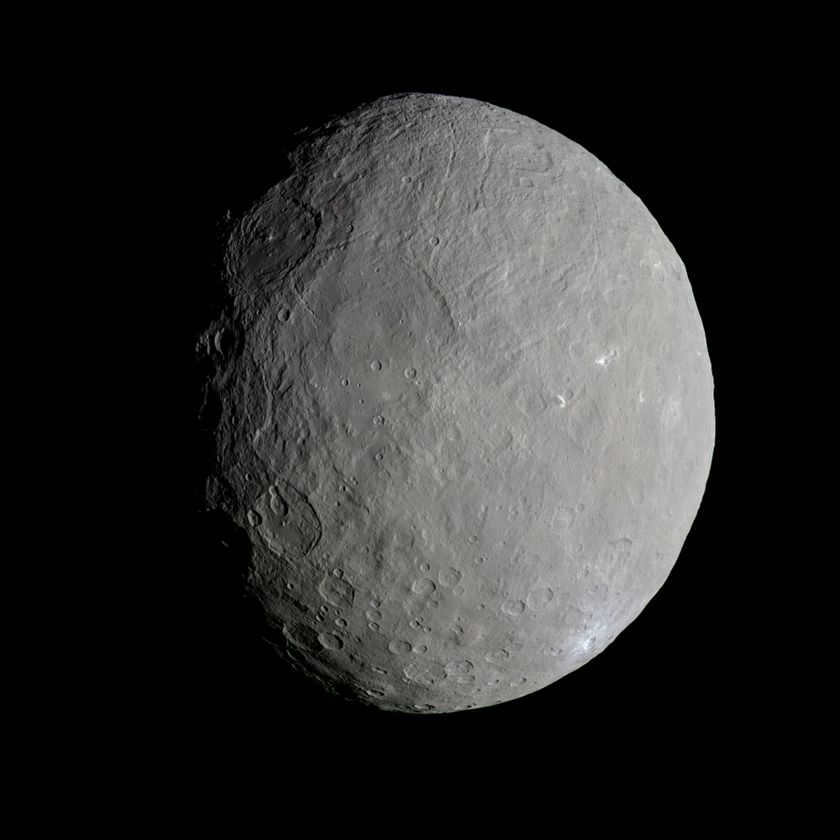
Following the unsuccessful quest for a planet situated between Jupiter and Mars, astronomers found themselves at a loss. Nevertheless, over time, the asteroid belt started captivating an increasing number of scientists, resulting in the discovery of over 670,000 asteroids, of which 422,000 have been assigned unique numbers and 19,000 have been given names.
The primary motivations for studying asteroids can be broadly categorized into two areas. The first is to advance our knowledge in the field of basic science. Research on asteroids helps us gain a deeper understanding of the solar system’s structure, formation, and composition, as well as the behavior of the universe and its various components. Astronomers are actively investigating the nature of asteroids and their composition to further our understanding in this field. However, the significance and practical benefits of studying these celestial bodies may not be immediately apparent, so let us illustrate this with an example.

The potential collision sites of asteroid Apophis, which is the nearest asteroid threat to our planet
The theory of the origin of the modern terrestrial environment suggests that water appeared on the surface of our planet. However, it is widely known that during the early stages of its development, the Earth was too hot for any water to remain after it cooled down. It was previously believed that water was later delivered by comets, but recent studies of the composition of comet water have shown that it differs significantly from Earth’s water. In 2010, scientists discovered ice on Themis, one of the largest asteroids in the main asteroid belt. This finding suggests that asteroids may have delivered water to Earth. Furthermore, hydrocarbons and certain molecules that could have played a role in the emergence of life on Earth were also detected on Themis.
The primary reason for studying asteroids is their potential threat to Earth. We have seen in many disaster movies the devastation that can occur when an asteroid collides with our planet. To prevent such disasters, astronomers closely monitor asteroids that pose a risk to Earth. One such asteroid is Apophis, which has a diameter of approximately 325 meters. To put this into perspective, the Chelyabinsk meteorite had a diameter of 17 meters. In 2029, Apophis will pass near Earth, with its trajectory coming within 35,000 km of our planet. There is also a possibility of a collision in 2036.
Enjoyed this article? Share it with your friends!

This term has different definitions, consult Composite image (scale).
Composite image (to scale) of asteroids captured with great detail. As of 2011, the following were included, arranged by size: (4) Vesta, (21) Lutetia, (25143) Itokawa.

Asteroids (formerly known as minor planets) are small celestial bodies that orbit the Sun within the Solar System. These objects are significantly smaller and less massive than planets, and they often have irregular shapes and lack atmospheres. It is also possible for asteroids to have satellites.
Definitions [ ]
The term asteroid was coined by composer Charles Burney [1] and introduced by William Herschel. It was derived from the Greek words ἀστεροειδής, meaning “star-like”, and ἀστήρ, meaning “star”, and εἶδος, meaning “kind, appearance, quality”. The reason for the term’s creation was that these objects appeared as points of light, similar to stars, when observed through a telescope. In contrast, planets appear as disks when observed through a telescope. The exact definition of the term “asteroid” is still not established. Prior to 2006, asteroids were also referred to as minor planets.
The main factor used for classification is the size of the celestial body. Objects with a diameter larger than 30 m are classified as asteroids, while smaller objects are referred to as meteoroids [2].
Asteroids in Our Solar System

The Solar System has now identified hundreds of thousands of asteroids. As of January 11, 2015, the database contained 670,474 items, with 422,636 having accurately determined orbits and assigned official numbers [4], and more than 19,000 having official names [5] [6]. It is estimated that there may be between 1.1 and 1.9 million objects larger than 1 km in the solar system [7]. The majority of the known asteroids are concentrated in the asteroid belt located between the orbits of Mars and Jupiter.
The estimated total mass of all asteroids in the main belt is 3.0-3.6×10 21 kg [8], which is approximately only 4% of the Moon’s mass. Ceres alone has a mass of 9.5×10 20 kg, which accounts for about 32% of the total mass. When combined with the three largest asteroids, Vesta (9%), Pallada (7%), and Hygeia (3%), they make up 51% of the total mass. This means that the majority of asteroids have a negligible mass when compared to astronomical standards.
Asteroid Research [ ]
The exploration of asteroids commenced following the detection of the planet Uranus by William Herschel in 1781. Its average heliocentric distance happened to correspond to the 18th century in 1789, during which a group of astronomers were on the hunt for a planet that, according to the Titius-Bode rule, should have been located approximately 2.8 astronomical units away from the Sun – between the orbits of Mars and Jupiter. The objective was to record the coordinates of all the stars within the zodiacal constellations at a specific moment. The coordinates were then cross-checked on subsequent nights, with objects that had shifted by a significant distance being highlighted. The projected displacement of the sought-after planet was presumed to be around 30 Ceres, which was accidentally discovered by the Italian astronomer Piazzi in 1801, on the first night of the 19th century. Three additional asteroids – (2) Pallada, (3) Juno, and (4) Vesta – were subsequently discovered in the following years, with Vesta being the last one found in 1807. After an additional 8 years of unsuccessful searching, the majority of astronomers concluded that there was nothing else to be found and halted their exploration.
Despite facing challenges, Carl Ludwig Henke persisted in his quest to discover new asteroids. In 1830, he resumed his search and, after fifteen years, he successfully identified Astrea, which was the first newly discovered asteroid in almost four decades. Less than two years later, he also found Geba. Henke’s determination inspired other astronomers to join the search, leading to the discovery of at least one new asteroid per year (except in 1945).
In 1891, Max Wolf introduced a groundbreaking method for asteroid detection. Fast forward a century, and the official number of identified asteroids has reached an impressive 385,000, with 18,000 of them having been named.
Asteroid Naming Convention
The practice of naming asteroids has evolved over time. Initially, asteroids were named after heroes from Greek mythology. However, as the field progressed, discoverers were granted the freedom to choose any name for their findings, including their own. In the early days, female names dominated the list of asteroid names, with male names reserved for those with unique orbits, such as those closer to the Sun than Mercury. However, this gender-based naming convention eventually fell out of favor, and asteroids are now named without regard to their orbit characteristics.
Not every asteroid is eligible to be given a name; only those whose orbit is fairly accurately calculated. There have been instances where an asteroid was named many years after its discovery. Prior to the orbit being determined, the asteroid is assigned a temporary designation that corresponds to the date it was discovered, such as 1950 DA. The numbers represent the year, while the first letter indicates the number of the half-month in which the asteroid was discovered (in the example above, it was the second half of February). The second letter signifies the sequence number of the asteroid within that half-month; in our example, it was the first asteroid discovered. Since there are 24 half-months and 26 English letters, two letters are not used in the designation: I (due to its similarity to the number one) and Z. If the number of asteroids discovered within a half-month exceeds 24, the alphabet is recycled, with the second letter being assigned the index 2, the next recycled letter being assigned the index 3, and so on.
After being given a name, an asteroid is officially identified by a combination of a number (in ordinal form) and a name, such as (1) Ceres or (8) Flora.
Establishing the structure and dimensions of an asteroid [ ]

Asteroid (also known as minor planet) was first discovered by the English astronomer William Herschel in 1802. Throughout the 19th century, other astronomers used a similar method to measure the brightness of asteroids. However, this method had a major drawback as it often resulted in significant discrepancies in the results. For instance, different scientists obtained measurements of the asteroid Ceres that differed in size by a factor of ten.
One of the easiest and highest quality techniques is the transit method. When an asteroid moves in relation to Earth, it occasionally passes in front of a distant star, a phenomenon known as asteroid occultation. By measuring the duration of the decrease in brightness of the star and having knowledge of the distance to the asteroid, its size can be determined with great precision. This approach enables accurate determination of the size of sizable asteroids like Pallada [11].
Nonetheless, it is possible to easily determine the albedo itself. The key is that asteroids with lower brightness, meaning they reflect less solar radiation in the visible range, absorb more radiation and consequently emit it as heat in the infrared range.
The polarimetry method is another approach to determine the shape of an asteroid. This involves observing changes in its brightness while it rotates, allowing for the determination of its rotation period. Furthermore, this method can identify significant structures on the asteroid’s surface [11]. Additionally, valuable findings have been obtained using the [10].
The classification of asteroids is primarily based on their orbital characteristics and the analysis of the sunlight reflected by their surfaces.
Groups and Families Based on Orbits
Asteroids are categorized into various groups and families based on their orbits and spectral classes.
In 1975, Clark R. Chapman, David Morrison, and Ben Zellner developed a classification system for asteroids that took into account their color, albedo, and the spectrum of sunlight reflected from their surfaces. Initially, this classification system identified three types of asteroids:
- Carbonaceous asteroids, which make up 75% of known asteroids.
- Silicate asteroids, which make up 17% of known asteroids.
- Metallic asteroids, which constitute the majority of the remaining asteroids.
Since then, this classification system has been expanded to include more types as additional asteroids are studied in greater detail.
- The albedo of this asteroid is estimated to be between 0.17 and 0.35, and it has a reddish color in the visible part of the spectrum.
- Compared to other carbonaceous asteroids, this one generally has a higher albedo.
- This asteroid has an albedo of 0.02-0.05 and an even reddish spectrum with no distinct absorption lines.
- Its mineral composition results in a high albedo and an almost flat (and colorless) reflectance spectrum in the visible range, indicating strong ultraviolet absorption.
- With an albedo of 0.02-0.07, this asteroid has a smooth reddish spectrum without clear absorption lines.
- The spectra of these asteroids show bright and broad olivine and metal lines.
- This asteroid has a high albedo and a reddish reflectance spectrum at 0.7 microns.
- Albedo and reddish spectrum (with moderate absorption at a wavelength of 0.85 μm) resemble the spectra of silicate and iron asteroids (chondrites), but differ in higher absorption line content at a wavelength of 1 μm.
It is important to note that the number of known asteroids assigned to a specific type may not accurately reflect reality. Determining certain types can be challenging, and the classification of a particular asteroid may change with more thorough research.
Spectral classification issues [ ]
The initial basis for spectral classification relied on three distinct types of material found in asteroids:
Nonetheless, there is uncertainty surrounding whether this classification truly determines an asteroid’s composition with absolute certainty. Although asteroids of different spectral classes indicate varying compositions, there is no conclusive evidence suggesting that asteroids within the same spectral class consist of identical materials. Consequently, the scientific community rejected the new system, leading to the discontinuation of spectral classification implementation.
Size distribution [ ]
| 100 m | 300 m | 500 m | 1 km | 3 km | 5 km | 10 km | 30 km | 50 km | 100 km | 200 km | 300 km | 500 km | 900 km |
| 25,000,000 | 4,000,000 | 2,000,000 | 750,000 | 200,000 | 90,000 | 10,000 | 1,100 | 600 | 200 | 30 | 5 | 3 | 1 |
It is believed that Jupiter did not reach its current mass solely through accretion during its early stage. Instead, the smaller bodies in the asteroid belt are thought to be remnants from collisions that occurred during or after Jupiter’s gravity scattered the original belt [15]. As for Ceres and Vesta, they grew large enough to undergo gravitational differentiation, with heavy metals sinking to their cores and lighter rocks forming their crusts [16].
The Kuiper Belt, which is located beyond the asteroid belt, was formed over 2.6 astronomical units away. While most objects in the Kuiper Belt were eventually ejected by Jupiter’s gravity, there are still some that remain [17].
The Peril of Asteroids [ ]
Even though Earth surpasses all known asteroids in size, a collision with a celestial body larger than 3 km could lead to the destruction of civilization. A collision with a smaller body (but still over 50 meters in diameter) has the potential to cause numerous casualties and extensive economic damage.
The larger and more massive the asteroid, the greater the danger it poses, but it is also much easier to detect. Currently, the most hazardous asteroid is known as Apophis, with a diameter of approximately 300 meters. If it were to collide with Earth, a direct hit could obliterate a large city, but it does not pose a threat to humanity as a whole.
On June 1, 2013, asteroid 1998 QE2 made its closest approach to Earth in the last 200 years. The distance between the two was 5.8 million kilometers [18].
The initial 30 celestial bodies [ ]
Signs and icons [ ]
The primary 37 celestial bodies possess astronomical signs. The information is consolidated in the presented chart.
| ⚳ | |
| (2) Pallada | ⚴ |
| (3) Juno | ⚵ |
| (4) Vesta | ⚶ |
| (5) Astrea | |
| (6) Geba | |
| (7) Irida | |
| (8) Flora | |
| (9) Metida | |
| (10) Hygeia | |
| (11) Parthenope | |
| (12) Victoria | |
| (13) Egeria | |
| (14) Irena | |
| (15) Eunomia | |
| (16) Psyche | |
| (17) Fetida | |
| (18) Melpomene | |
| (19) Fortuna | |
| (26) Proserpina | |
| (28) Bellona | |
| (29) Amphitrite | |
| (35) Leucophea | |
| (37) Fidesz. |
Related Articles:
- ↑The true origin of the term “asteroid” has been determined
- ↑Shustov B. M., Rykhlova L. В. Fig. 1.1 // Asteroid and comet danger: yesterday, today, tomorrow / Edited by B. M. Shustov, L. Rykhlova. В.. – M .: Fizmatlit, 2010. – 384 p. – ISBN 978-5-9221-1241-3. (see ISBN )
- ↑News Release – IAU0603: IAU 2006 General Assembly: Result of the IAU Resolution votes – IAU Press Release August 24, 2006
- ↑How Many Solar System Bodies
- ↑MPC Archive Statistics. Checked on January 11, 2013.Archived from the original source on January 24, 2012.
- ↑Minor Planet Names. Checked on January 11, 2013.Archived from the original source on July 5, 2012.
- ↑A new research study has revealed that there are twice as many asteroids in existence than previously believed. Checked on March 28, 2006.Archived from the original source on July 5, 2012.
- ↑Krasinsky, G. A.; Pitjeva, E. V.; Vasilyev, M. V.; Yagudina, E. I. (July 2002). “Hidden Mass in the Asteroid Belt”. Icarus158 (1): 98—105. doi:10.1006/icar.2002.6837.
- ↑Water ice has been discovered on an asteroid for the first time.
- ↑Tedesco, E. (June 14—18, 1993). “Asteroid Albedos and Diameters”. Proceedings of the 160th International Astronomical Union. Belgirate, Italy: Kluwer Academic Publishers. pp. 55—57.
- ↑Lang, Kenneth R. (2003). The Cambridge Guide to the Solar System. p. 390—391. ISBN978-0521813068. http://books.google.com/books?id=RdCUsMy3l7EC&pg=PA384.
- Chapman, C. R., Morrison, D., and Zellner, B. (1975). “Synthesis of polarimetry, radiometry, and spectrophotometry: Examining the surface properties of asteroids”. Icarus25: 104—130.
- McSween Jr., Harry Y.. Meteorites and Their Parent Planets. 0-521-58751-4.
- Davis 2002, «Asteroids III», cited by Željko Ivezić
- “The fossilized size distribution of the main asteroid belt” (2005). Icarus175. doi:10.1016/j.icarus.2004.10.026. Bibcode: 2005Icar..175..111B.
- Kerrod, Robin (2000). Asteroids, Comets, and Meteors. Lerner Publications Co. ISBN0585317631.
- William B. McKinnon, 2008, “On The Possibility Of Large KBOs Being Injected Into The Outer Asteroid Belt”.American Astronomical Society, DPS meeting #40, #38.03.
References [ ]
- Asteroids
- Interesting facts about asteroids
- Popular article in Around the World magazine
- Near-Earth Object Program.
- Space Lilliputians (link not available – history, copy)
- William Napier. The hazards of comets and asteroids
- List of all asteroids with numbers
- Asteroid names in alphabetical order
- Catalog of the orbital evolution of small solar system bodies
- Asteroids – trajectory of catastrophe. Video from Roscosmos TV studio. 2012.
- Lecture “Asteroid and comet danger: myths and reality” on 19.12.2012 by Shustov B.M. (video, lecture at the Moscow Planetarium)
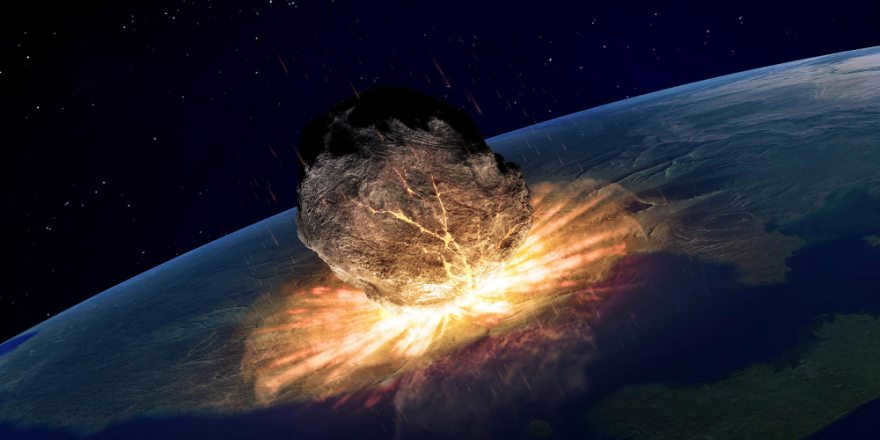
Asteroids provide us with a unique perspective on the solar system, allowing us to gain insights and make discoveries. These celestial bodies are among the oldest known objects and hold valuable secrets that can shed light on various cosmic mysteries. They hold clues about the formation of planets and the origins of life on Earth. Additionally, the Earth’s geological records indicate that asteroids can have a catastrophic impact on our planet, as evidenced by the existence of meteor craters.
In 2014, renowned astrophysicist and Queen guitarist Brian May, together with B612 Foundation President Danica Remy, Apollo 9 astronaut Rusty Schweikart, and filmmaker Greg Richters, established Asteroid Day. The primary goal of this initiative is to raise awareness about the potential dangers posed by asteroids and educate the public about the importance of studying them. By doing so, they aim to garner support for further research and exploration in this field.
In order to show our support for Asteroid Day, we have compiled a roster of 10 asteroids (and one comet that holds a special place in our hearts).
The asteroid responsible for the Tunguska impact

On the 30th of June in 1908, a tremendous explosion resonated through a forest in Siberia.
As per NASA, the impact of the explosion was so powerful that it flattened and uprooted eighty million trees, completely shearing off their branches. While no human lives were lost, numerous reindeer herds perished. Scientists have long theorized that a rocky celestial body detonated above the impact site, but intriguingly, no remnants have ever been discovered.
In 2007, researchers claimed to have identified an impact crater in a nearby lake. More recently, a paper published in the March edition of the Monthly Notices of the Royal Astronomical Society put forth an even stranger proposition: the asteroid collided with Earth’s atmosphere and then incredibly managed to rebound and return to outer space.
The Chicxulub Impact

Sixty-six million years ago, a celestial body with the same dimensions as San Francisco collided with the Yucatan Peninsula in Mexico. A surge of rocky fragments ascended into the atmosphere. A cataclysmic tidal wave traversed the globe. The collision resulted in extensive wildfires and the release of billions of tons of sulfur into the Earth’s atmosphere, creating a sun-blocking effect and ultimately cooling the planet.
This collision altered the course of existence on Earth. It is widely known that the consequences of this event endured for numerous years. Dinosaurs and numerous other animal species perished, paving the way for the emergence of perhaps the most perilous creature of all: humanity.

A detailed photo of the asteroid Ida
On the 29th of August, 1994, the Galileo spacecraft flew past 243 Ida. As stated by NASA, this was the second occasion that the spacecraft encountered an asteroid. It is also the initial asteroid to be found with a satellite.
According to NASA, Ida and its small satellite Dactyl are positioned in the asteroid belt between Mars and Jupiter and are categorized as a part of the Koronis asteroid family. Similar to Gaspra, it is an S-type asteroid.
(4) Vesta
Vesta is one of the largest asteroids in our solar system. It is located in the asteroid belt between Mars and Jupiter. Vesta is named after the Roman goddess of home and hearth. It was discovered in 1807 by astronomer Heinrich Wilhelm Olbers. Vesta has a diameter of approximately 525 kilometers and is irregular in shape. It is believed to be the remnant of a protoplanet that formed during the early years of the solar system. Vesta has a rocky surface and is covered in impact craters. It has been visited by the NASA Dawn spacecraft, which provided valuable information about its composition and geological history. Vesta is an important object of study for scientists, as it can provide insights into the early stages of planet formation.
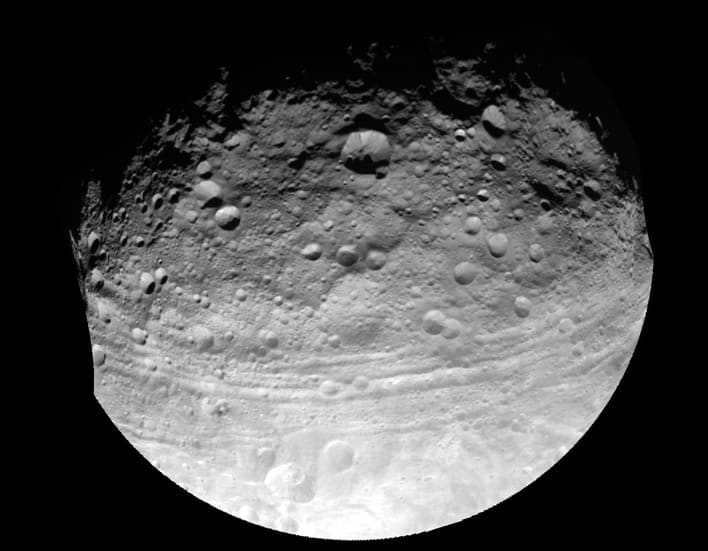

The Dawn spacecraft, operated by NASA, conducted a thorough investigation of the Vesta asteroid from 2011 to 2012, gathering an extensive amount of data about this celestial body.
During its mission, the spacecraft captured remarkable images of various features on the surface of Vesta, including a mountain in the southern hemisphere that surpasses the height of Mount Everest, as well as three crater formations resembling snowmen.
The Dwarf Planet Ceres
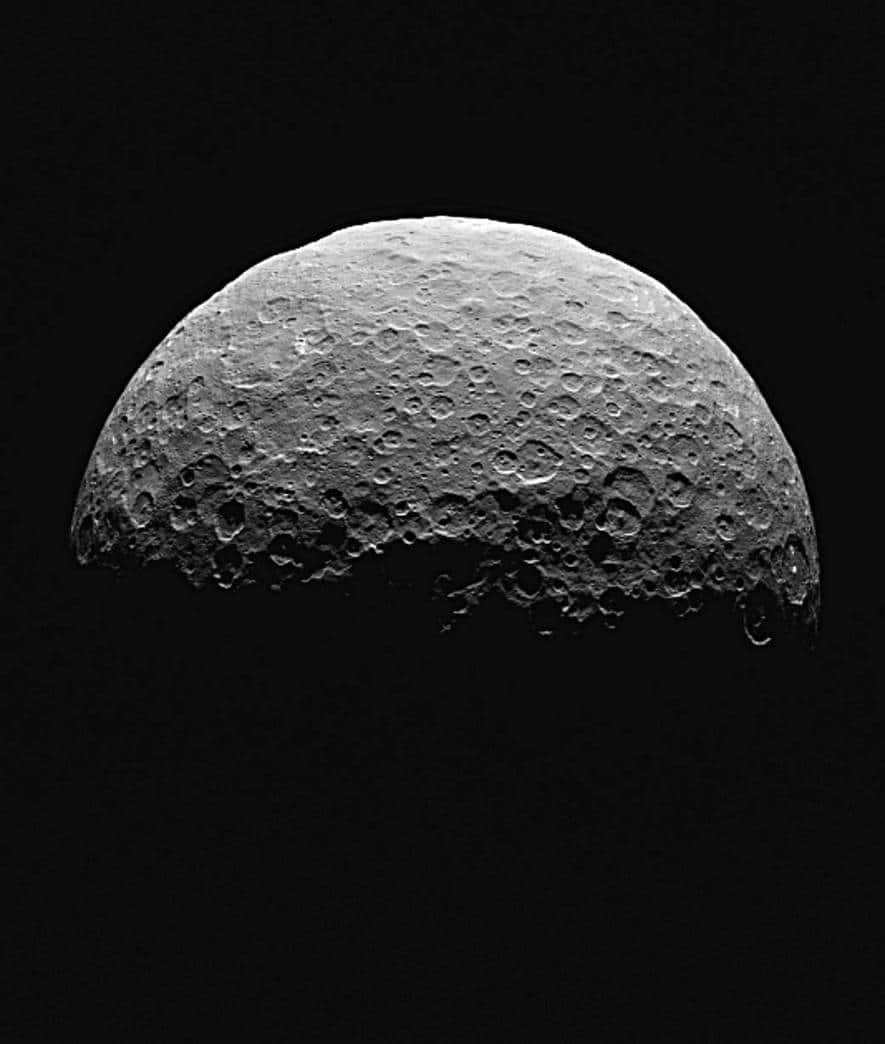
Ceres, initially observed by Italian astronomer Giuseppe Piazzi in 1801, holds the distinction of being the inaugural asteroid ever spotted. With a diameter of 580 miles, Ceres reigns supreme as the largest entity situated within the asteroid belt nestled between Mars and Jupiter. Its sheer size has led many scientists to classify it as a dwarf planet. Additionally, Ceres stands out as the first celestial body in the asteroid belt to possess a perfectly spherical shape, a product of its own gravitational forces.
In 2015, a NASA spacecraft embarked on a mission to Ceres, capturing high-resolution imagery and gathering valuable data about this enigmatic object. During its journey, the spacecraft uncovered evidence of cryovolcanism and successfully identified the presence of organic molecules on the surface of Ceres.
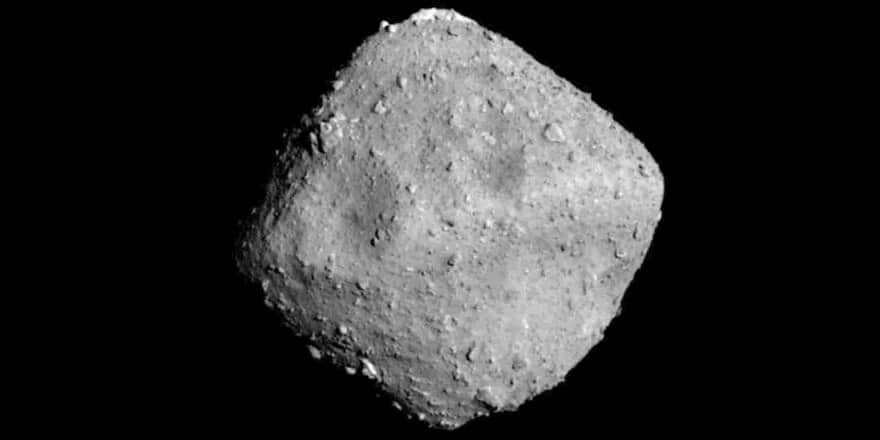
Ryugu, a typical C-type asteroid, serves as the focal point of a mission known as Hayabusa2 by the Japan Aerospace Exploration Agency (JAXA). In the previous year, a spacecraft discharged a projectile onto the surface of the asteroid and successfully collected a portion of the resulting debris.
Presently, the spacecraft is en route back to Earth, carrying a plethora of enigmatic cosmic treasures. Later this year, Hayabusa2 will pass by Earth and release a small capsule containing the collected samples. Undoubtedly, Ryugu will be subjected to extensive examination by scientists for many years to come.
(101955) Bennu
Rephrase the text, making it unique, using the English language and preserving the HTML markup:
(101955) Bennu


An up-close photograph capturing the intricate details of the asteroid Bennu
Bennu serves as the primary objective of NASA’s mission to collect samples. Since its arrival in 2018, the OSIRIS-REx spacecraft has been diligently examining this asteroid.
In the upcoming summer months, the spacecraft will descend to a low altitude and extract a small fragment of the asteroid to transport it back to Earth. A preliminary test of this procedure took place earlier this year. Scientists will have to exercise patience until 2023, when they can finally analyze and study this fascinating piece of the asteroid.
(65803) Didymus
can be paraphrased as
(65803) Didymus
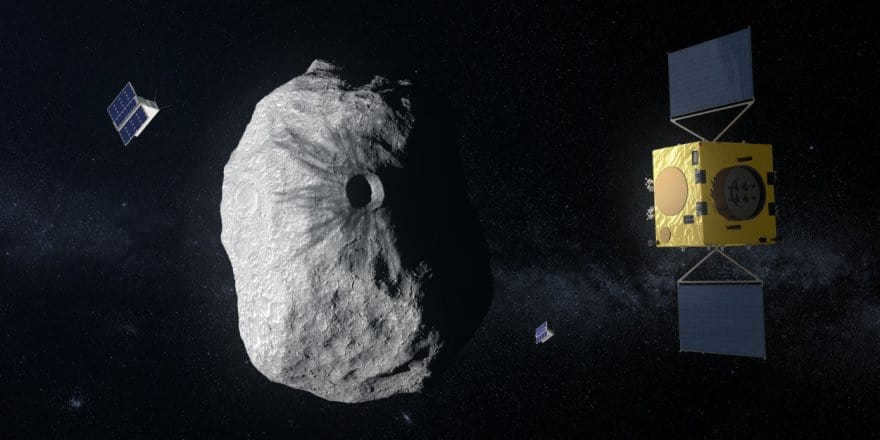
An artistic representation of the asteroid Didymus
The asteroid Didymus and its small companion Dimorph are the focus of a highly significant mission. NASA’s DART mission is set to disrupt the trajectory of a smaller asteroid (serving as a space rehearsal) as the larger asteroid approaches Earth. Scientists will attempt the kinetic impact method for the first time.
The spacecraft is scheduled to launch in 2021 and will arrive at the pair a year later. It will analyze the asteroids and then deploy a projectile to divert Dimorph from its path. Another spacecraft developed by the European Space Agency (ESA) will soon arrive at the asteroids to assess the extent of the impact.

An artistic depiction of asteroid OK 2019
In July of last year, a colossal asteroid came within 222,000 miles of Earth, equivalent to the size of a jumbo jet. Its proximity was only discovered a mere 48 hours prior. NASA promptly reassured the public that there was no cause for alarm.
Over 20,000 potentially hazardous objects have been identified in our solar system, yet the near encounter with OK 2019 serves as a poignant reminder that much remains to be done.
(99942) Apophis – The Great Destroyer

On April 13, 2029, our planet will be visited by a 1,100-foot-wide asteroid. NASA has announced that 99942 Apophis will come within 19,000 miles of Earth, disguising itself among some of the distant satellites orbiting our planet.
When it was discovered in 2004, this asteroid caused quite a commotion among astronomers due to its proximity. Initial predictions suggested a 2.7% chance of collision with Earth. However, subsequent observations have provided more accurate data, lowering the risk.
According to NASA, there is no need for alarm. In fact, this event presents an incredible opportunity to closely study the asteroid. Let us hope that Apophis, aptly named after the Egyptian “lord of chaos,” remains at a safe distance.
Comet 67P / Churyumov-Gerasimenko: A Celestial Phenomenon

A picture of the comet Churyumov/Gerasimenko. Image: Rosetta
Although not classified as an asteroid, we believe that Comet 67P/Churyumov-Gerasimenko should be included in our list.
In August 2014, the Rosetta spacecraft, operated by the European Space Agency, reached the comet after a decade-long journey from Earth. Over the course of nearly a year, the spacecraft orbited the comet and captured breathtaking images of its curved and rocky surface. The mission also resulted in significant discoveries, such as bouncing boulders and the presence of chemical components essential for life.
In November 2014, Rosetta released a lander, but unfortunately, it ended up in a shadowed area and eventually lost power. It briefly awakened one more time almost a year later. On September 30, 2016, the spacecraft’s mission concluded as it crashed into the comet, which is shaped like a duck.
The diameter of asteroids is comparable to that of seas and the largest lakes in the world. Our collection consists of the ten largest asteroids in the solar system.
Asteroids are celestial bodies that orbit around the Sun in our system. Over 1 million have been discovered so far. Most of them are located in the main asteroid belt, which is a cluster of small celestial bodies between the orbits of Mars and Jupiter. Nine asteroids from our ranking circle around the Sun in this region.
Interestingly, there are over 4000 asteroids that are considered potentially dangerous to Earth. Even those with a size slightly larger than 100 meters and approaching Earth at a distance of less than 7.5 million km pose a threat of collision with our planet. Imagine the scale of the real giants!
Read the My Planet report to learn more about the largest asteroids and their movement.
Vesta: the biggest asteroid

Diameter is approximately 525 kilometers.
For a considerable period, the most massive asteroid was Ceres, measuring around 950 km in diameter, making it only two and a half times smaller than Pluto. In 2006, Ceres was reclassified as a dwarf planet, and currently, the largest asteroid in the main asteroid belt is Vesta. If this asteroid were to suddenly appear on Earth, it would cover an area two and a half times larger than Lake Baikal.
However, Vesta does not pose any threat to our planet. The closest distance it can come to Earth is 177 million kilometers. Interestingly, Vesta is the only asteroid visible to the naked eye, and the most recent sighting by humans occurred in spring 2021.

Diameter: approximately 512 km.
Pallada takes second place among the largest asteroids. It was originally discovered by German astronomer Heinrich Olbers in 1802. This asteroid was named after the ancient Greek goddess of wisdom, Athena Pallada. Interestingly, the chemical element palladium also takes its name from this asteroid.
With a distance of about 513 million kilometers from Earth, there is no need to fear Pallada. However, its large orbital inclination makes it difficult to study with spacecraft. Nevertheless, spectroscopic analysis has revealed a significant presence of silicon on its surface.
Interamnia: an extremely massive celestial body.
Diameter: approximately 326 km.
Interamnia is one of the largest and heaviest asteroids in the main asteroid belt. Its size is slightly smaller than that of the White Sea, and it ranks third in terms of mass, surpassed only by Vesta and Pallada, with a mass of 3.9 * 10 19 kg. Despite its significant size, this celestial body was only discovered in 1910 by the Italian astronomer Vincenzo Cerulli. The asteroid was given the name Interamnia, which is the ancient Latin name for the city of Teramo, where Cerulli’s observatory was located.
Due to its dark surface and its distance from Earth, which is approximately 562 million kilometers, Interamnia remains a relatively mysterious object with limited information available. In fact, it is three times farther from Earth than Vesta, making it even more challenging to study.

Diameter: There are various estimates ranging from 270 to 326 km.
Imagine mentally adding Lake Onega to Lake Baikal – that’s approximately the size of the body of water the asteroid would completely submerge in if it were on Earth. However, it is too far away for that, about 691 million kilometers from Earth. The surface of the asteroid has a crater that is three times larger than the Yellowstone volcano.
Interestingly, initially the American astronomer Raymond Dugan, who discovered the celestial body in 1903, named it after Professor David Todd. However, according to tradition, asteroids were given female names, so David became Davida.
Europa: an immense chunk of pumice
The asteroid has a diameter of approximately 303 kilometers.
This celestial body is twice the size of Lake Ladoga and has a density slightly higher than that of water. This results in a porous surface. As a result, the asteroid has a smaller mass of 1.65 * 10 19 kg compared to other large asteroids. Europa is located about 381 million kilometers from Earth, but its orbit is elongated, causing its distance to vary greatly from other celestial bodies, including the Sun. A year on Europa lasts just over 5.4 Earth years, and a day lasts 5.6 hours.
Euphrosyne: a celestial body that has reconstructed itself

The asteroid’s diameter is approximately 267 kilometers.
If the asteroid were to suddenly appear on Earth, it would cover an area the size of Lake Michigan, which is the third largest among the Great Lakes in the United States and Canada. The asteroid has a nearly perfect spherical shape and its surface is free from large craters. It is believed that this is because around 280 million years ago, the asteroid collided with another celestial body, resulting in its complete destruction and subsequent reformation. Some of the debris from the collision formed a satellite.
The asteroid is located 628 million kilometers away from Earth.
Diameter : approximately 255 kilometers.
The asteroid is roughly the same size as the Sea of Azov. Its distance from our planet is approximately 433 million kilometers. Although this celestial body is not well-studied, it is known to have a orbital period of 4.3 years and is one of the largest asteroids. Furthermore, its orbit does not intersect with that of Earth. Additionally, according to the fictional plot of the Strugatsky brothers’ novel “The Interns,” there was a laboratory on Eunomia dedicated to experimental testing of the theory of relativity.
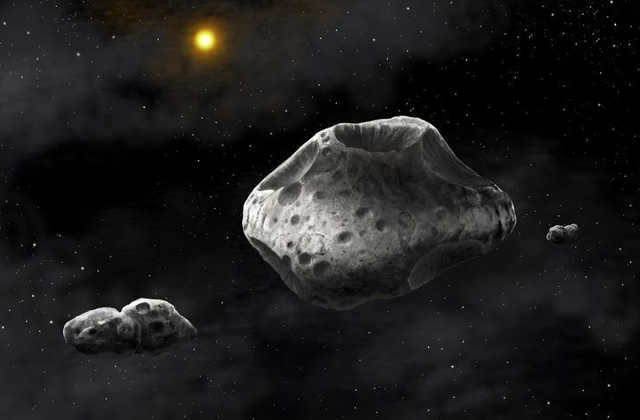
Diameter: approximately 253 kilometers.
Sylvia is about the same size as Eunomia and is located approximately 560 million km away from Earth. It was first discovered in 1866 by English astronomer Norman Pogson and was named after Rhea Silvia, the mother of the legendary brothers Romulus and Remus. In 2005, the two satellites orbiting Sylvia were named after the brothers.
Scientists believe that Sylvia is a “rubble pile” – a term used by astronomers to describe objects that are composed of debris and held together by their own gravity. This type of system is thought to have formed from a collision with another celestial body.
Cybele: A contentious component

The diameter of this asteroid is approximately 237 kilometers.
Back in 1861, German astronomer Ernst Tempel made the discovery of this asteroid, although its name sparked a heated debate. Initially, there was a suggestion to name it after the then King Maximilian II of Bavaria. However, during that period, asteroids were being named after figures from Greek mythology, and they were typically given female names. This led to opposition from several astronomers who objected to the proposed name Maximiliana. Ultimately, the asteroid was named after Cybele, the goddess who symbolizes Mother Nature.
The size of the asteroid has been a topic of debate for a long time. Different measurements have been given, ranging from 245 km to 330 km. The most recent data, from 2004, suggests a diameter of about 237 km. If the asteroid were to impact Earth, it would be completely submerged in the Dead Sea. However, this scenario is unlikely as the asteroid is currently located 625 million kilometers away from our planet.
Not all large asteroids are part of the main asteroid belt.


